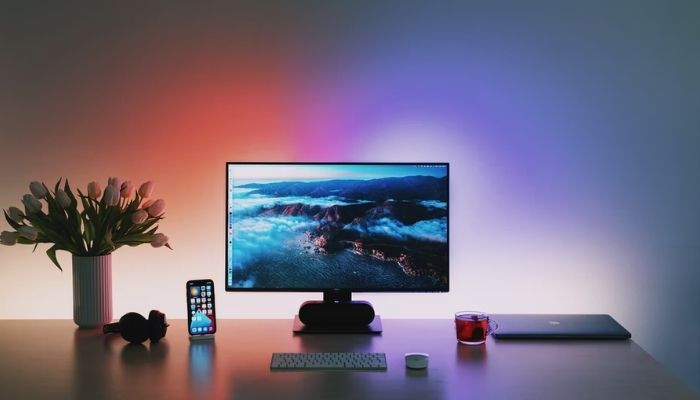The life of a computer monitor is dependent on the type of light source utilized and the amount of time spent on the monitor each day. Your computer monitor is just as critical as the PC setup’s central processor unit (CPU).
A damaged computer monitor will undoubtedly reduce productivity and prevent you from accomplishing critical tasks. While we don’t have complete control over its lifespan, keeping it in good operating order and considering a few factors will help you determine when it’s time to replace it.
Another aspect that contributes to determining whether a computer monitor will survive longer or not is its quality. Compared to purchasing inexpensive, low-quality monitors, investing in a high-quality monitor allows you to save money.
This guide will help you in comprehending How Long Does a Monitor Last and the technical components of extending the life of your monitor, practical recommendations for maintaining a screen in good working condition.
Monitors, particularly LCDs, typically have a long life. If your PC monitor survives the first five years without a single pixel turning sour, you’ll be able to use it for many more years – as long as you take adequate care of it and don’t abuse it.
Symptoms of a Monitor Failure
Users may receive alerts in advance if there are issues with their monitors. Recognizing these warning signs can assist you in resolving your computer difficulties before they become worse. The following are some indicators of a faulty monitor.
Dead Pixels
Dead pixels are blank pixels on the monitor that will not disappear unless the monitor is replaced due to hardware failure. If your display has them, you may need to replace them to avoid more severe computer problems.
Monitor Burn-in
Monitor burn-in is a term that refers to the ghost-like appearance of a graphic that is displayed frequently on the screen. You can avoid this by utilizing screensavers or other related software like JScreenFix.
Unpredictable Display
Suppose your monitor has a pattern of turning on and off, hibernating intermittently, powering up suddenly, or other behaviors that prohibit it from displaying screen images. In that case, this could be caused by a defective power supply.
Screen-related Issues
When a monitor fails, it does not appear black. It will either generate a faint green tint or display a blue screen. Typically, this is related to hardware and software issues. When a CRT display fails, you may hear a popping sound.
LCD devices frequently fade silently when they fail. Additionally, you may detect a mild burning smell when a monitor is damaged.
Evaluate the Monitor
When troubleshooting a faulty monitor, the first check is that the component and power cords are connected properly. Additionally, you can attach another monitor to the computer to determine if the issue is isolated to the first display.
If the second monitor does not function properly, this could be due to a damaged graphics card. It would be efficient if you took the computer to a professional to ascertain the cause of the problem.
How Long is a Monitor’s Lifespan?

The life of a monitor is highly reliant on various factors, including the type of display, the backlight settings, and how it is used.
Bear in mind, however, that the type of display, the quality of the hardware, and how it is used can all have a significant impact on the monitor’s lifespan and its longevity.
The longevity of a computer monitor is determined by the type of light source used. Additionally, it will depend on the number of hours the product is used per day.
How Long Are LCD Monitors Expected to Last?
This type of monitor has a flat-panel display. It uses a liquid crystal solution placed between two layers of polarising material as its light source.
LCD monitors typically have a life expectancy of 30,000–60,000 hours. It equates to a 10-20 years service life if you use your desktop setup for 8 hours per day.
How Long Are LED Monitors Expected to Last?
LED monitors, also known as light-emitting diodes, are typically considered the best options on the market because they incorporate the latest technology and, as a result, have longer life spans significantly if you choose a reputable brand.
Their primary advantage is their capacity to produce more light and colour while being more energy-efficient.
It also results in a significantly extended longevity of 80,000 to even 120,000 years. It implies that your LED monitors can last up to 20 years with proper maintenance.
How Long Are CRT Monitors Expected to Last?
CRT monitors have a life expectancy of around 25,000 to 30,000 hours. Using the monitor for eight hours per day will take you between eight and ten years to accumulate 30,000 hours.
A CRT monitor works by projecting electrons onto a fluorescent screen through an electron gun contained within a vacuum tube. These monitors are typically large, delicate, and expensive.
The Factors That Affect the Monitor’s Life
The length of time you may use your computer display depends on how well you care for it. The following sections discuss various elements that can either prolong or reduce the life of a computer display.
Name of Brand
The more established the brand, the higher the construction quality and lifespan of the product. Thus, the more money you spend on your present monitor, the longer you can use it. Cheaper brands are that way because they frequently use low-quality components.
Robust Build
If the monitor’s build quality is good, you may expect it to endure a long time. While higher-quality displays are more expensive, they typically last longer than cheaper monitors.
Long-Lasting Components
Premium brands make use of superior and more robust components. If your monitor is constructed with high-quality equipment, including the screen and connections, you may anticipate it to endure a long time. Their electronic components are more resistant to the demands of everyday use.
Hours of Usage
If you are a big video game user, you cannot expect a low-quality display to last for years. And if you combine heavy use with inconsistent repair and maintenance, it will fail to function correctly and will not reach its authorized service life.
If you use your monitor for approximately 8 hours every day, it should last between 30,000 and 60,000 hours. If you use it more frequently during the day, it will not last as long.
Quality of Maintenance and Care
The Maintenance and Care you give for your monitor significantly impacts its lifespan. If you follow a strict cleaning and maintenance program, your monitor will last along. However, you cannot expect it to last for many years if it is not.
How Can You Prolong the Life of Your Monitor?
The following are some suggestions for extending the life of this critical computer component.
Use of a Surge Protector
Utilizing a surge protector can dramatically increase the lifespan of your display unit. Connecting your monitor directly to a wall-mounted power outlet exposes it to daily electrical current variations. Surge protectors, by definition, protect sensitive electronic components from fluctuating currents.
Keep Air Vents Open
A monitor’s air vents are often situated on the top or sides. Avoid excessive heat accumulation by keeping those air vents clear at all times. Additionally, this will avoid harm to its components.
Additionally, you can utilize a vacuum cleaner or brush to remove dirt, grit, and grime from the ventilation holes.
Set the Screen Saver to Solid Black
Make sure that the screensaver on your computer is set to solid black, rather than a more elaborate and colourful pattern. It conserves energy and extends the life of the display’s LCD lights. Additionally, this process may aid to lessen the burn-in impact.
Maintain a Stable, Clean, and Safe Work Area
The location of your monitor has a considerable impact on its longevity. If your work table is in a high-traffic area, there is a good possibility that someone’s hands or elbows will accidentally strike it.
Additionally, if you already have an unstable work table, the monitor may tumble to the floor, resulting in disaster. The best approach to extend the life of your monitor is to keep it stable and away from other people.
Avoid Turning It On and Off
Switching your display on and off repeatedly during the day will have a detrimental effect on its components. If you constantly turn on and off the display, its internal components will not perform efficiently over time. After a while, some of these parts may even fail and entirely degrade.
FAQs – How Long Does a Monitor Last?
How Long Does Computer Monitor Last?
LCD monitors are generally rated for 30,000 to 60,000 hours of use, which equates to ten to twenty years if used eight hours per day. These monitors have a flat display, and their light source is a liquid crystal solution sandwiched between two sheets of polarizing material.
How Can You Describe if Your Monitor Is Going Bad?
Typically, when a monitor fails, it simply refuses to power on and displays an entirely blank screen. Another hardware or software issue exists if the monitor glows a faint green or obtains a blue screen. Specific individuals fear that when monitors go wrong, they will explode.
Do Monitors Get Worse Over Time?
Yes! Monitors use CCFL lighting that gradually dims. However, this is a lengthy process that may take years if your monitor is not used correctly.
Conclusion
According to the preceding article, while monitors are often expected to last between 30,000 and 60,000 hours, this figure can vary significantly depending on a variety of other factors. It is the life expectancy of a brand new monitor if used frequently for eight hours each day.
Your screen’s life expectancy varies significantly based on the brand, service years, construction, maintenance, and, most crucially, the type of display.
Suppose you purchase a high-quality display and maintain it properly. In that case, you can expect it to last several years. You can arrange monthly cleaning and maintenance to keep it in good condition.
